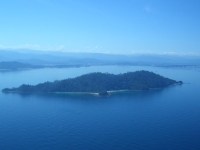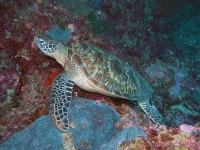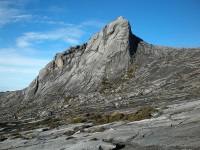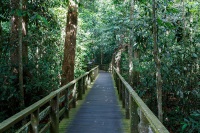Things to do in Sabah
Covered in dense jungle and surrounded by ocean, Borneo's enduring reputation for danger repels many would-be visitors, but also adds to its mystique. Sabah occupies the northern part of the island and its many natural splendours will speak to nature lovers. Hikers, divers and extreme sports fanatics will find lots to do, and animal lovers can enjoy the region's incredible biodiversity.
Sabah's list of attractions includes the Sepilok Orangutan Sanctuary, where visitors can watch and sometimes interact with the loveable animals in their natural habitat, and the Tunku Abdul Rahman National Park. The park comprises five gorgeous islands, which offer white beaches, coral reefs and jungle hikes. Sipadan Island is touted as the best dive site in the world, and is a bucket list item for any serious scuba diver. Sabah is also home to Malaysia's highest mountain: the impressive Mount Kinabalu. The two-day hike to the summit is one of the most popular activities in Malaysia.
Apart from its wealth of parks, reserves, and sanctuaries, Sabah has a number of interesting cultural attractions. Village tours and treks to tribal settlements in the rainforest are fascinating, and the North Borneo Steam Railway offers a round-trip from Kota Kinabalu. The route takes passengers through the Sabah landscape and back in time, as the experience is distinctly colonial. Travellers who are interested in World War II history should visit the extremely moving Sandakan Prison Camp Memorial. It delves into the experiences of prisoners of war and the Sandakan death marches.

Tunku Abdul Rahman National Park
Five pristine islands make up Tunku Abdul Rahman National Park, with each idyllic setting comprising white beaches, offshore coral reefs and inland forests teeming with animal life…
Tunku Abdul Rahman National Park
Five pristine islands make up Tunku Abdul Rahman National Park, with each idyllic setting comprising white beaches, offshore coral reefs and inland forests teeming with animal life. These destinations are all perfect for camping, trekking, swimming and snorkelling. Gaya Island is the largest of the five and its status as a forest reserve since 1923 has helped preserve its dense tropical forest. Manukan Island is the second largest and the most popular with Malaysian locals. Mamutik Island is the smallest, though it makes up for that through sheer beauty. Sapi Island is very popular with foreign tourists, while Sulug Island is the most pristine and untouched of the chain.
Website www.sabahparks.org.my

Sipadan Island
This mushroom-shaped island is known among divers around the world for its unique seascape and exceptional beauty. Around 3,000 varieties of fish, hundreds of coral species, and nu…
Sipadan Island
This mushroom-shaped island is known among divers around the world for its unique seascape and exceptional beauty. Around 3,000 varieties of fish, hundreds of coral species, and numerous rays, sharks and turtles populate its translucent waters. Sipadan Island certainly tops the Malaysian itinerary for serious scuba divers, given that it's located in the world's most bio-diverse marine habitat. The famous underwater explorer Jacques Cousteau once described it as 'an untouched piece of art'. Indeed, the Malaysian government has undertaken to preserve the fragile ecosystem by ordering dive resorts off the island, limiting the daily number of divers allowed in the water, and banning night dives.

Mount Kinabalu
Mount Kinabalu rises from the Kinabalu National Park and, at an impressive 13,500-foot (4,101m), is one of the highest peaks in Southeast Asia. It's a relatively easy climb, though…
Mount Kinabalu
Mount Kinabalu rises from the Kinabalu National Park and, at an impressive 13,500-foot (4,101m), is one of the highest peaks in Southeast Asia. It's a relatively easy climb, though, with tourists of varying ages and fitness levels enjoying the two-to-three-day ascent. Most people spend a night at Laban Rata before mounting the summit. Along with being the name of a rest house that caters for hikers, Laban Rata is the name most people use for the area. The summit is a three-to-four-hour hike away from the hostel. Hikers should leave between 2am and 3am if they want to catch one of the area's magical sunrises.
Website www.sabahparks.org.my/

Sepilok Forest Reserve and Orangutan Sanctuary
Sabah District's vast, enchanting equatorial rainforest is home to the Sepilok Orangutan Sanctuary, where orphaned orangutans find temporary shelter and rehabilitation before their…
Sepilok Forest Reserve and Orangutan Sanctuary
Sabah District's vast, enchanting equatorial rainforest is home to the Sepilok Orangutan Sanctuary, where orphaned orangutans find temporary shelter and rehabilitation before their re-release into the forest. The centre was set up in 1964 and gives tourists and researchers the priceless opportunity to observe and engage with the animals in their natural habitat. Visitors are restricted to the walkways but orangutans often come over to interact. Photography is permitted, though tourists will pay an extra charge for bringing in a camera. The Sandakan Rainforest Discovery Centre (RDC) is also within the Sepilok Forest Reserve. The remarkable place allows guests to explore the jungle canopy on a series of raised platforms and walkways.
Website www.sabahtourism.com



